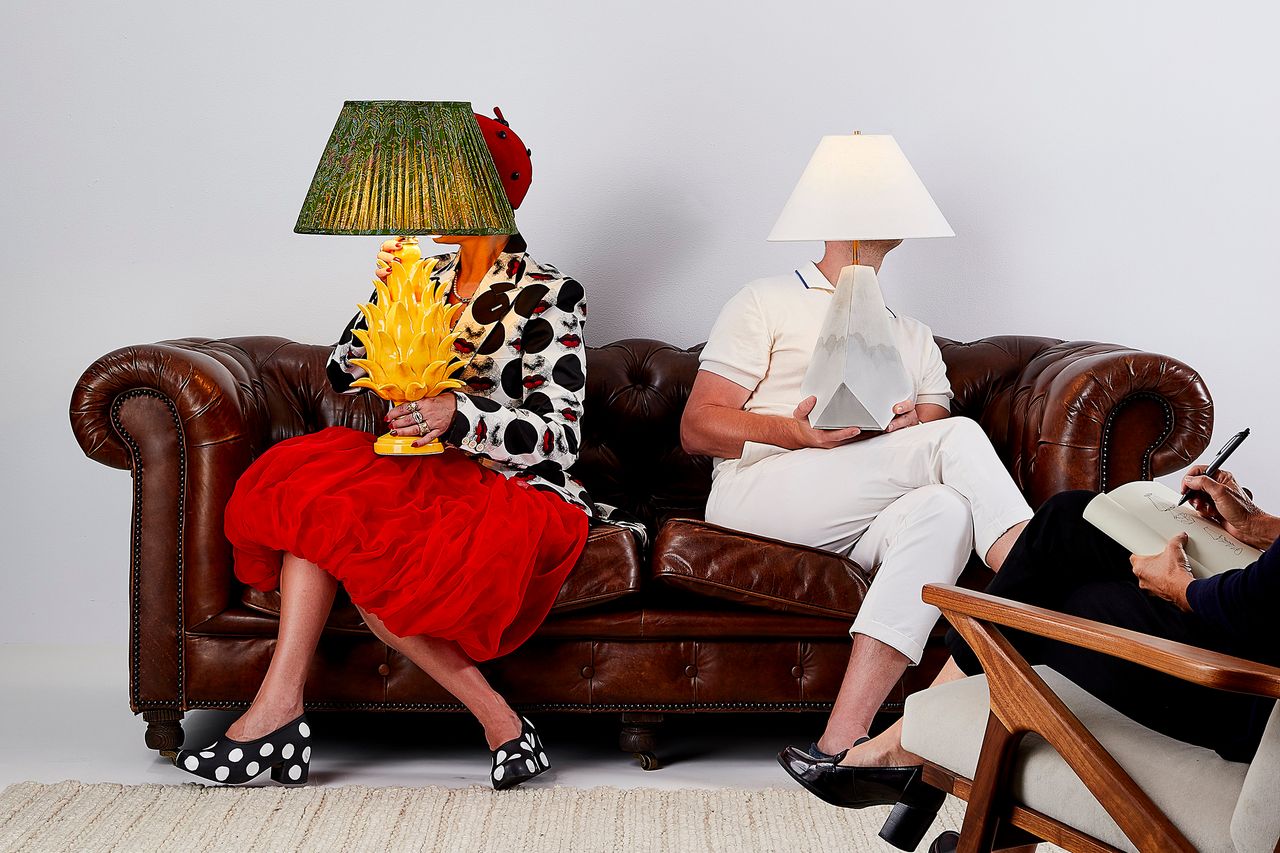Do You Need An Interior Designer Or A Marriage Counsellor?
Interior designers often employ therapy-like techniques to find stylish compromises for clients with warring aesthetics.
My husband James and I are decorating our new vacation house in the Rocky Mountains of Colorado and have taken on so much more than we can chew that we’re choking…mostly because I’ve been a rude co-designer. Years of writing about decorating have turned me into the Joan Rivers of home décor, minus the comedy.
He wants wood, leather and black metal. If I don’t get white upholstery, one too many throw pillows and patterns as dainty as the pinnules on a maidenhair fern, I will perish.
When James texts me an image of a chair or light to consider, it’s often more masculine than I can bear—and I’ll text too brusquely why I hate it. My behaviour is not OK, especially because my spouse is one of the kindest souls on earth.
I’m not the only person whose style clashes with her partner’s as painfully as pink paisley and tartan plaid. “Disagreements between couples on residential projects is the leading reason our studio decided three years ago to pursue more hospitality and commercial projects,” said Dallas, Texas, designer Jean Liu. “Maybe we were unlucky, but we realized how unequipped we are to handle marital strife.”
It wouldn’t hurt an interior designer to bone up on strategies for couples-conflict resolution. In a 2021 survey by Houzz, a website and online community dedicated to home improvement and decorating, 11% of the couples among the 75,470 U.S. respondents declared they found it challenging to work with their spouse on a renovation. In the Houzz U.K. 2022 Renovations and Relationships Survey, 16% of 1,250 respondents said they considered separating during the renovation process.
When it comes to cohabitated spaces, the stakes are high, in part because your home is “an expression of who you are and your personality,” said Boston family therapist Terrence Real, author of “Us: Getting Past You and Me to Build a More Loving Relationship” (Goop Press, 2022).
Los Angeles designer Kevin Klein has found that when working with couples, disagreements are as unavoidable as shipping delays. Consequently, during initial consultations, Mr. Klein asks clients how they’ll handle any impasse that might arise. “They always look at me cross-eyed, like ‘What are you talking about?’ But that moment inevitably comes six months down the line, when we’re doing relationship counselling rather than designing.”
Real-estate developers Ilana and David Duel credit Mr. Klein for steering them through their own renovation harmoniously. “It’s really hard between husband and wife to make decisions,” said Ms. Duel. “You can spend hours and hours on just the tile.” She longed for an all-white house with light wood floors, while Mr. Duel and Mr. Klein sought to maintain the 1930s abode’s Spanish character.
Today, such unlikely roommates as a boxy, white marble coffee table—a nod to her taste—and drippy Murano crystal sconces—a reflection of Mr. Duel’s—are shacked up happily in the couple’s living room. “If you decide to hire a designer, know that they’re much better at designing than you are,” she said.
In case you don’t have the coin to take on a personal interiors pro, video design consultations offered by websites like the Expert, billed by the hour, can yield affordable tiebreaker advice. Decorist’s new service, for example, lets you book a 30-minute Zoom session with a pro for $59.
Whether hiring an expert or going it alone, Mr. Klein recommends you set up “office hours,” as he puts it. “When you come home after a long day, you don’t want to address these design decisions,” he said. “It’s not sexy; it doesn’t feel right.” Dedicating specific chunks of time to the process, periods when you’re both well-rested, is a better way to hear the other person’s side, he says, “than while you’re sitting in bed together watching TV.”
Another sanity-saving strategy: Choose décor that’s easily swappable. When Los Angeles designer Rydhima Brar’s client sought a swashbuckling 1970s-inspired graphic wallpaper, her other half didn’t find it shagadelic. The peace offering? Removable wallpaper they could switch out if he still balked down the line. Ultimately, he was into it.
Pictures, in these situations, are worth a thousand exhausting negotiations. “Most people don’t have the vocabulary to define their style,” said New York City designer Rozit Arditi. Gray Walker, a designer in Charlotte, N.C., often asks client couples to “pin” images of things they like on Pinterest boards, an easy ask, and then seek compromise with the help of those visual aids. “I have found that hearing both parties and giving each person a bit of what they want is the way to go without conflict,” she said.
For the living room of her clients’ 1930s Georgian revival home in Charlotte, Ms. Walker navigated warring aesthetics by acknowledging each—installing a Chinese screen and timeworn Oushak rug for him, an antique obsessive, and a bergère upholstered in faux fur as well as a minimal brick-red-velvet sofa for her, a fan of all things modern.
Seeking middle ground can lead to unexpected dynamism. When he first met his husband, Atlanta designer Vern Yip gravitated toward clean lines and Asian antiques. But his husband “brought a lot of European antiques into the picture that I never wanted and always felt kind of claustrophobic around,” Mr. Yip said. The happy medium they found was far from middle-of-the-road. “He had this dining table that had a ton of carvings. It was really well made but very old European. And we paired it with these Brno chairs—black leather and chrome—and it just sang, you know? They gave each other space.”
Pulling a common nostalgic thread from a pair of clients’ pasts helped PJCArchitecture find a design detente for the couple’s lakeside second home in Indian Lake, N.Y. Rob Maher, a retired Metropolitan Opera chorus member, asked for something resembling a Japanese tea house, while his wife, Deborah Allton-Maher, a retired Metropolitan Opera dancer and attorney, longed for the lusciously loggy cabin in the 1981 film “On Golden Pond.” After learning that the couple had toured Japan several times, the New York City architects found consensus in a shared memory of shou sugi ban (charred wood), a common feature of the country’s temples. The bridging fix: The architects sided a modern Adirondack pitched-roof house with the material. “We loved it,” said Ms. Allton-Maher.
Therapist Mr. Real’s bottom line: “You can bully your way and get what you want in the short run. But you’ll breathe in that solution in the long run, in your partner’s resentment,” he said. “If you frame it as a power struggle in which one of you wins and the other one loses, you both lose.”
I didn’t want my husband and I both to lose, so I (mostly) quit being a tyrant. I relented on two of James’s desires, a pair of leather-and-walnut chairs and channel-tufted leather bar stools. And you know what? They look great next to my white bouclé sofa and the Deco-ish barrel armchairs I chose in a cinnamon velvet—and I think they’re all destined to live happily ever after.
 Copyright 2020, Dow Jones & Company, Inc. All Rights Reserved Worldwide. LEARN MORE
Copyright 2020, Dow Jones & Company, Inc. All Rights Reserved Worldwide. LEARN MORE
This stylish family home combines a classic palette and finishes with a flexible floorplan
Just 55 minutes from Sydney, make this your creative getaway located in the majestic Hawkesbury region.
As Paris makes its final preparations for the Olympic games, its residents are busy with their own—packing their suitcases, confirming their reservations, and getting out of town.
Worried about the hordes of crowds and overall chaos the Olympics could bring, Parisians are fleeing the city in droves and inundating resort cities around the country. Hotels and holiday rentals in some of France’s most popular vacation destinations—from the French Riviera in the south to the beaches of Normandy in the north—say they are expecting massive crowds this year in advance of the Olympics. The games will run from July 26-Aug. 1.
“It’s already a major holiday season for us, and beyond that, we have the Olympics,” says Stéphane Personeni, general manager of the Lily of the Valley hotel in Saint Tropez. “People began booking early this year.”
Personeni’s hotel typically has no issues filling its rooms each summer—by May of each year, the luxury hotel typically finds itself completely booked out for the months of July and August. But this year, the 53-room hotel began filling up for summer reservations in February.
“We told our regular guests that everything—hotels, apartments, villas—are going to be hard to find this summer,” Personeni says. His neighbours around Saint Tropez say they’re similarly booked up.
As of March, the online marketplace Gens de Confiance (“Trusted People”), saw a 50% increase in reservations from Parisians seeking vacation rentals outside the capital during the Olympics.
Already, August is a popular vacation time for the French. With a minimum of five weeks of vacation mandated by law, many decide to take the entire month off, renting out villas in beachside destinations for longer periods.
But beyond the typical August travel, the Olympics are having a real impact, says Bertille Marchal, a spokesperson for Gens de Confiance.
“We’ve seen nearly three times more reservations for the dates of the Olympics than the following two weeks,” Marchal says. “The increase is definitely linked to the Olympic Games.”

Getty Images
According to the site, the most sought-out vacation destinations are Morbihan and Loire-Atlantique, a seaside region in the northwest; le Var, a coastal area within the southeast of France along the Côte d’Azur; and the island of Corsica in the Mediterranean.
Meanwhile, the Olympics haven’t necessarily been a boon to foreign tourism in the country. Many tourists who might have otherwise come to France are avoiding it this year in favour of other European capitals. In Paris, demand for stays at high-end hotels has collapsed, with bookings down 50% in July compared to last year, according to UMIH Prestige, which represents hotels charging at least €800 ($865) a night for rooms.
Earlier this year, high-end restaurants and concierges said the Olympics might even be an opportunity to score a hard-get-seat at the city’s fine dining.
In the Occitanie region in southwest France, the overall number of reservations this summer hasn’t changed much from last year, says Vincent Gare, president of the regional tourism committee there.
“But looking further at the numbers, we do see an increase in the clientele coming from the Paris region,” Gare told Le Figaro, noting that the increase in reservations has fallen directly on the dates of the Olympic games.
Michel Barré, a retiree living in Paris’s Le Marais neighbourhood, is one of those opting for the beach rather than the opening ceremony. In January, he booked a stay in Normandy for two weeks.
“Even though it’s a major European capital, Paris is still a small city—it’s a massive effort to host all of these events,” Barré says. “The Olympics are going to be a mess.”
More than anything, he just wants some calm after an event-filled summer in Paris, which just before the Olympics experienced the drama of a snap election called by Macron.
“It’s been a hectic summer here,” he says.

AFP via Getty Images
Parisians—Barré included—feel that the city, by over-catering to its tourists, is driving out many residents.
Parts of the Seine—usually one of the most popular summertime hangout spots —have been closed off for weeks as the city installs bleachers and Olympics signage. In certain neighbourhoods, residents will need to scan a QR code with police to access their own apartments. And from the Olympics to Sept. 8, Paris is nearly doubling the price of transit tickets from €2.15 to €4 per ride.
The city’s clear willingness to capitalise on its tourists has motivated some residents to do the same. In March, the number of active Airbnb listings in Paris reached an all-time high as hosts rushed to list their apartments. Listings grew 40% from the same time last year, according to the company.
With their regular clients taking off, Parisian restaurants and merchants are complaining that business is down.
“Are there any Parisians left in Paris?” Alaine Fontaine, president of the restaurant industry association, told the radio station Franceinfo on Sunday. “For the last three weeks, there haven’t been any here.”
Still, for all the talk of those leaving, there are plenty who have decided to stick around.
Jay Swanson, an American expat and YouTuber, can’t imagine leaving during the Olympics—he secured his tickets to see ping pong and volleyball last year. He’s also less concerned about the crowds and road closures than others, having just put together a series of videos explaining how to navigate Paris during the games.
“It’s been 100 years since the Games came to Paris; when else will we get a chance to host the world like this?” Swanson says. “So many Parisians are leaving and tourism is down, so not only will it be quiet but the only people left will be here for a party.”
This stylish family home combines a classic palette and finishes with a flexible floorplan
Just 55 minutes from Sydney, make this your creative getaway located in the majestic Hawkesbury region.






















